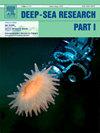利用高分辨率模式模拟研究了enso引起的南印度洋海洋变率的途径和影响
IF 2.1
3区 地球科学
Q2 OCEANOGRAPHY
Deep-Sea Research Part I-Oceanographic Research Papers
Pub Date : 2025-05-21
DOI:10.1016/j.dsr.2025.104532
引用次数: 0
摘要
太平洋水团可以通过印尼通流(ITF)和阿古拉斯流(AC)泄漏到达大西洋,构成了全球海洋传送带的重要路线。然而,El Niño-Southern涛动(ENSO)引起的海洋变率是否能有效穿透这条路径,在很大程度上仍不确定。在这项研究中,我们利用高分辨率(水平分辨率0.1°)海洋模式的实验,重新审视了太平洋源海洋信号的路径及其对南印度洋环流的影响。实验时间为2014-2022年,覆盖2015-2016年超级厄尔Niño和2020-2022年连续厄尔Niña。我们的研究结果揭示了太平洋斜压罗斯比波从海洋大陆延伸到马达加斯加的主要路径,ENSO信号在向西移动时迅速减弱。2014-2022年期间,来自太平洋的海洋信号解释了116°E的ITF外流强度变化的~ 95%,南赤道流(SEC)的~ 66%和东北马达加斯加流(NEMC)的~ 17%。通过这种“海洋通道”机制,2015-2016年厄尔尼诺Niño导致2016年东北太平洋环流增强,2017年马达加斯加东南海流减弱。相比之下,对于以海洋内部变率为主的交流系统,这种海洋通道效应通常可以忽略不计。这些结果限制了ENSO对SIO环流调制作用的程度,并暗示太平洋和大西洋之间有效的海洋通道通信必须在十年或更长时间尺度上发生。本文章由计算机程序翻译,如有差异,请以英文原文为准。
Pathways and impacts of ENSO-induced oceanic variability in the southern Indian Ocean investigated with high-resolution model simulations
Pacific Ocean water masses can reach the Atlantic through the Indonesian Throughflow (ITF) and Agulhas Current (AC) leakage, constituting an essential route of the global ocean conveyor belt. However, whether the oceanic variability induced by El Niño-Southern Oscillation (ENSO) can efficiently penetrate through this route remains largely uncertain. In this study, we utilize experiments of a high-resolution (0.1° in horizontal resolution) ocean model to revisit pathways of Pacific-origin oceanic signals and their impacts on the Southern Indian Ocean (SIO) circulation. The experiments are performed for the 2014–2022 period to cover the 2015–2016 super El Niño and the 2020–2022 consecutive La Niña. Our results reveal a main pathway of Pacific-origin baroclinic Rossby waves stretching from the Maritime Continent to Madagascar, with ENSO signatures weakening rapidly as proceeding westward. The Pacific-origin oceanic signals explain ∼95 % of the strength variability in the ITF outflow at 116°E, ∼66 % of that in the South Equatorial Current (SEC) and ∼17 % of that in the Northeast Madagascar Current (NEMC) during 2014–2022. Through this “oceanic channel” mechanism, the 2015–2016 El Niño led to a strengthened NEMC in 2016 and a weakened Southeast Madagascar Current (SEMC) in 2017. By contrast, this oceanic channel effect is generally negligible for the AC system which is dominated by ocean internal variability. These results constrain the extent of ENSO's modulation effect on the SIO circulation and imply that effective ocean-channel communication between the Pacific and the Atlantic has to occur on decadal or longer timescales.
求助全文
通过发布文献求助,成功后即可免费获取论文全文。
去求助
来源期刊
CiteScore
4.60
自引率
4.20%
发文量
144
审稿时长
18.3 weeks
期刊介绍:
Deep-Sea Research Part I: Oceanographic Research Papers is devoted to the publication of the results of original scientific research, including theoretical work of evident oceanographic applicability; and the solution of instrumental or methodological problems with evidence of successful use. The journal is distinguished by its interdisciplinary nature and its breadth, covering the geological, physical, chemical and biological aspects of the ocean and its boundaries with the sea floor and the atmosphere. In addition to regular "Research Papers" and "Instruments and Methods" papers, briefer communications may be published as "Notes". Supplemental matter, such as extensive data tables or graphs and multimedia content, may be published as electronic appendices.

 求助内容:
求助内容: 应助结果提醒方式:
应助结果提醒方式:


